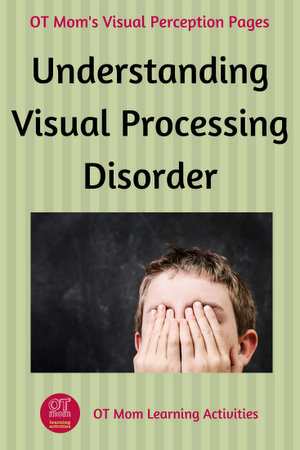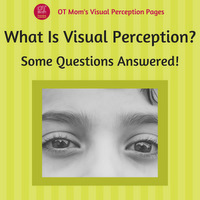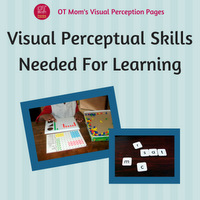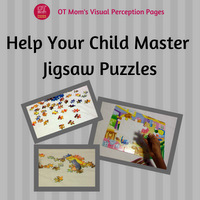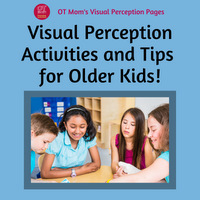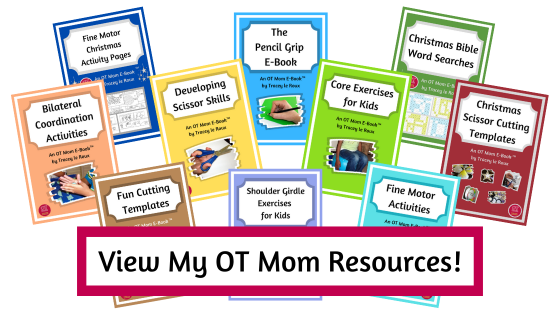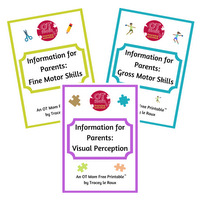- Home Page
- Visual Perception Activities
- Visual Processing Disorder
Visual Processing Disorder
Visual processing disorder is a term which is often used among educational and special needs professionals. Depending on who uses the term, it can be quite a broad category, as a quick scan of the internet will show.
It may not be an official diagnosis, but it is an acknowledgement that your child is struggling to process what he or she sees, and can give you and the therapist some guidelines for intervention.
With this article, I try to help parents understand how a visual processing disorder can affect their child.
Click on the quick links to find some answers to your questions on this page.
- What are the signs that my child may have visual processing issues?
- Is it an vision issue or a visual processing issue?
- What are the signs of possible functional vision problems
- What is the connection between visual processing and SPD (Sensory Processing Disorder)?
- How does a visual perception delay affect my child's learning?
- Are there any resources to help parents?
- Related pages on my site
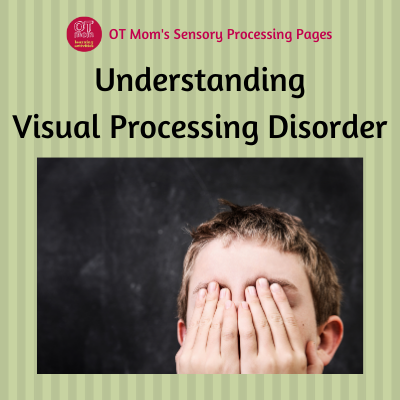
The advice and learning activities on this website are NOT a replacement for evaluation and treatment by an occupational therapist. If you suspect your child has visual perceptual delays, please seek a professional opinion and read my disclaimer before proceeding
I sometimes link to products (#Ad) that are similar to those I use and love. If you do purchase something through my links, I will receive a small commission that helps support my site - thank you!
Signs Of A Visual Processing Disorder
These are just a few of the symptoms that may suggest that your child may have visual processing issues.
The symptoms depend on the type of delay and can vary greatly from child to child.
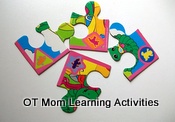
- struggles to copy words or drawings accurately
- quality of written work is poor despite adequate fine motor skills
- avoids puzzles, mazes and other “visual perception” activities
- letters or words are reversed or inverted when reading and/or when writing (this is normal for young children but not for a 10 year old)
- does not see the difference between similar numbers or letters
- struggles to learn letters and numbers, can’t make sense of letters and numbers
- very poor reader – struggles to remember sight words or to identify letters in order to blend
Either the brain is not making sense of what it sees (ie a visual processing disorder)…or it is not receiving accurate information from the eyes in the first place (a vision issue)!
Vision Issue Or Visual Processing Issue?
How do we know if the problem lies with the message that the eyes are receiving or with the brain’s processing?
We can only know for sure if the child has undergone a complete eye function examination to rule out a visual problem.
 Vision or Visual Processing?
Vision or Visual Processing?A behavioral optometrist tests much more than just 20/20 vision – he or she will, (among other things) check whether the eyes are working well together to focus on both stationary and moving objects.
If these vital eye functions are poor, your child’s eyes will not be sending accurate information to the brain.
The next section covers some of the indications that your child may have a functional vision issue, rather than a visual processing issue:
Signs Of Possible Functional Vision Problems
If your child's eyes are not working well together, these are a few of the signs that you may see in your child during school work:
- tilts or moves head while reading or writing
- covers one eye when reading or writing
- loses place or leaves out words when reading or writing
- reads very slowly, with a great deal of effort
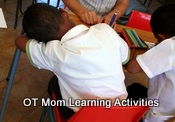 Tilts head when working
Tilts head when working- reading or writing deteriorates as the lesson goes on
- complains of tired eyes / rubs eyes / eyes watering during reading and writing work
- easily distracted and shows poor concentration, owing to the great deal of effort it takes to maintain visual focus during classwork
If you notice any of these signs in your child, please take your child to a behavioral optometrist for an evaluation. (Even if they have passed a basic 20/20 vision eye exam!)
If your child is currently not making good progress despite receiving therapy intervention for visual processing disorder please ask your therapist or teacher for a referral to a behavioral optometrist.
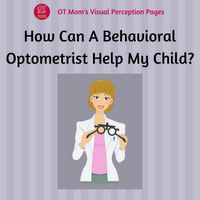 A Behavioral Optometrist May Help!
A Behavioral Optometrist May Help!
You could save a lot of time and effort in the long run by getting to the root of the problem sooner.
Visual Processing and Sensory Processing
As vision is one of our important senses, it is worth taking a look at how visual processing can be affected by sensory processing disorder (SPD).
The descriptions are not comprehensive and I encourage you to chat to an occupational therapist if you feel your child struggles with one or more of these sub-categories of SPD that involve the visual sense.
- Visual Defensiveness (Visually Over-Responsive)
Your child may have visual defensiveness if he/she dislikes and avoids bright lights and being outdoors on a sunny day.
This child may also dislike watching moving objects such as merry-go-rounds, or may feel stressed by the unpredictable movements of kids in the playpark.
He/she may easily become dizzy or nauseous being in an environment which is visually busy (eg the bustle of a fairground).
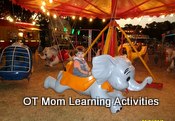 Do bright, flashing lights stress your child?
Do bright, flashing lights stress your child? - Visually Under-Responsive
Your child may be visually under-responsive if he or she is slow to take note of what is seen and therefore slow to respond appropriately.
For example, a child may walk in the path of a moving swing, or may not duck out of the way of a falling object, because the brain is under-responsive to the visual information coming from the eyes.
- Poor Visual Discrimination
Among other things, a child with this difficulty may find it hard to differentiate similar looking letters and words (such as b, d, p, or 2, 5, S).
He or she may struggle with depth perception, spatial relationships and with reading other people’s non-verbal body language (eg facial expressions).
Further down this page, I describe how a child's learning can be affected by specific visual perceptual delays.
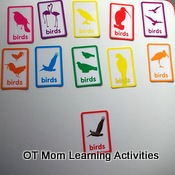 Can your child see differences/ similarities?
Can your child see differences/ similarities? - Poor Visual-Motor Skills
A child with poor visual motor skills finds it hard to coordinate hand or foot movements (the motor component) with what is seen (the visual component).
This affects gross motor activities such as catching or kicking a ball, eye-hand coordination, as well as fine motor activities such as threading beads, tracing handwriting patterns, doing buttons and coloring within the lines.
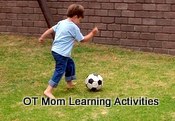 Can your child coordinate the hands and feet with what the eyes are seeing?
Can your child coordinate the hands and feet with what the eyes are seeing? - Visual Dyspraxia
Closely related to poor visual-motor skills, visual dyspraxia affects a child’s ability to plan what to do based on what is seen.
This child may fill up a cup to overflowing because the brain cannot use the visual information (of the cup getting fuller) to plan the appropriate response (to stop pouring before it reaches the top).
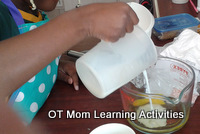 Good visual processing helps kids pour accurately
Good visual processing helps kids pour accuratelyThis child may struggle to position the body to catch a ball or to reach for an object, often overreaching or coming up short. He or she may also struggle to plan and layout a poster for a project, or to identify what is wrong with a layout (eg a table setting).
- Occupational Therapy And The Visual Aspect of SPD
A sensory-trained occupational therapist who is working with a child who struggles with visual processing disorder will usually include vestibular (movement) activities, as well as activities that work on the core and shoulder muscles (postural activities). These activities may have an effect on the visual system and can help to improve visual processing skills.
How Does A Visual Processing Delay Affect My Child?
There are many areas of visual perception and often teachers and professionals differ in the terms they use to describe various visual perceptual tasks or even to define visual processing disorder.
This list is not comprehensive, but should cover the areas most commonly referred to within the school environment, and gives a brief description of what a delay might look like.
- Form Constancy
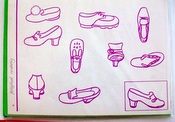 Form constancy activity
Form constancy activityWhat it is:
The ability to recognize and label an object
correctly even when it is viewed from a different perspective, or even
if the color and size are different.
Kids with delays may struggle to: recognize numbers and letters when the font changes, or when they are presented in a different context (eg when they see them in the playground instead of in the classroom)
- Visual Discrimination
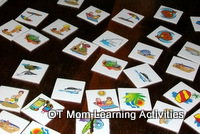 Visual discrimination activity
Visual discrimination activityWhat it is:
The ability to see subtle differences and to see if something matches up or if it does not belong.
Young kids with delays may struggle to:
match clothing, socks, or cutlery, especially when the differences are
subtle, and may not see the difference between similar objects. They
miss out small details in pictures and books.
School-going kids with delays may struggle to: see differences between similar looking letters and words (eg b / d, b / p, 5 / S, won’t / want, car / cat)
- Figure-Ground Perception
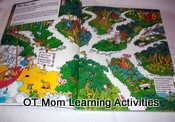 Figure-ground perception activity
Figure-ground perception activityWhat it is:
The ability to visually focus on one specific piece of information in a busy background.
Kids with delays may struggle to:
find
information on a busy blackboard and find words in a dictionary. Map
skills may be poor. They may also lose their place when reading or
copying work.
- Visual Closure
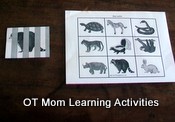 Visual closure activity
Visual closure activityWhat it is:
The ability to correctly perceive an object or word, even when it is partly hidden.
Kids with delays may struggle to:
make sense of smudged words and different fonts. They may find it hard to read messy or cursive writing, and can't make sense of road signs that are partly obscured.
- Visual Memory
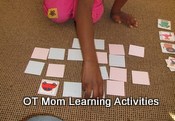 Visual memory activity
Visual memory activityWhat it is:
The ability to recall the visual details of what you have seen.
Kids with delays may struggle to:
copy words and sentences quickly as they can only memorize one letter at a time. They may struggle with basic phonics, easily forgetting what the letter for a particular sound looks like. They may struggle to learn sight words.
- Visual Sequential Memory
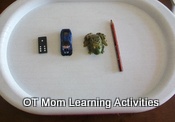 Visual sequential memory activity
Visual sequential memory activityWhat it is:
The ability to remember the visual details in the correct sequence.
Kids with delays may struggle with:
spelling and reading, where the correct sequence of letters must be recalled. When doing multiple digit addition and subtraction, visual sequential memory is essential to aid in the correct copying of the digits from the board or from a book.
Some Helpful Resources
These are some helpful resources that I have shared with parents over the years. They are designed to promote your child's optimum development.
If you suspect your child has a visual processing disorder, please do not hesitate to get a professional opinion. Consult an occupational therapist and/or a behavioral optometrist.
- Books
The books below may be found at your local library, but I have linked to them on Amazon for your convenience.
These are my affiliate links and I earn a small commission if you purchase through one of my links but you are under no obligation to purchase anything.
- Eyes on Track #Ad is an immensely helpful and practical resource to help kids develop their functional visual skills. It explains the importance of visual tracking and convergence skills, among others, and gives lots of really practical activities and worksheets for kids to do.
This book does NOT replace an assessment by a behavioral optometrist if you are concerned about your child's visual skills. However, it is a fantastic and practical resource to promote your child's optimum development.
- If your child has sensory processing disorder, or struggles with visual processing from an SPD point of view, you may find The Out of Sync Child#Ad to be a helpful and empowering resource.
It is a great book to share with family members, teachers and anyone else who is working with your child.
- Other Websites
These helpful websites open in a new tab/window.
- Visual Processing Disorder (NCLD)
- What Vision Therapy is and isn't - and what it can do to help your child.
I hope that some of this information on visual processing disorder was helpful to you!
Thanks for visiting! Why not sign up for my occasional newsletter to stay in touch with new pages on my site?
- Home Page
- Visual Perception Activities
- Visual Processing Disorder
Share this page to help others!
Related Pages On My Site
Didn't find what you were looking for? Try a search of my site!
